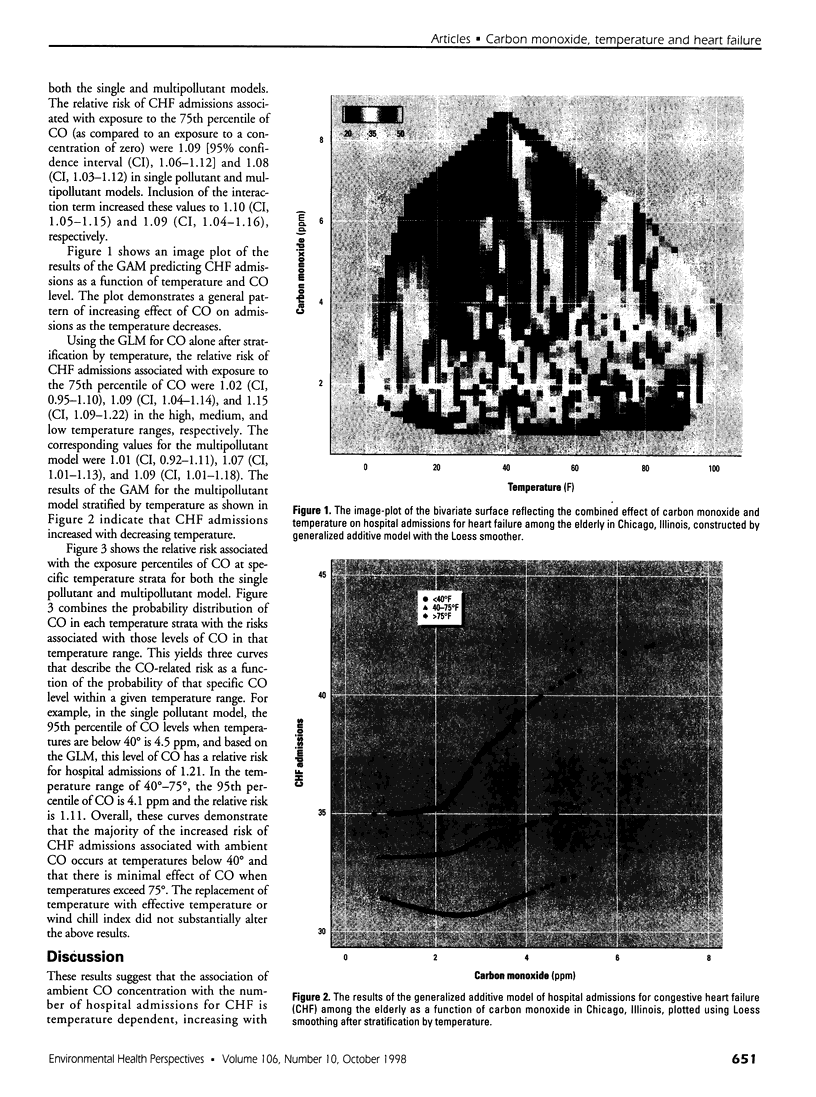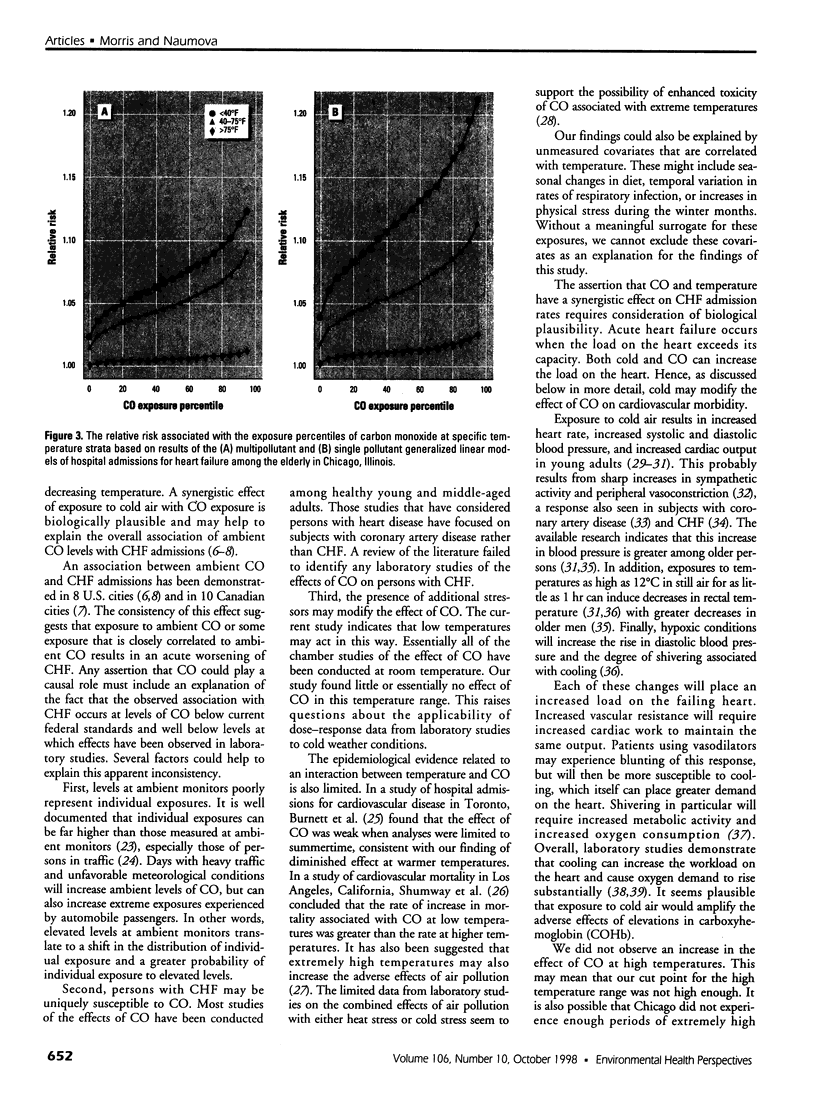Abstract
The combined effects of carbon monoxide and low temperature on daily variation in hospital admissions for congestive heart failure (CHF) were examined for a 4-year period in Chicago, Illinois. Medicare hospital admissions for CHF were analyzed as a function of the maximum hourly temperature, maximum hourly levels of carbon monoxide (CO), and other criteria pollutants in Chicago for each day of the 4-year period (1986-1989). The regression analyses for the time series were conducted using single and multipollutant models with interaction terms and adjustments for weather, weekly cycles, seasonal effects, and secular trend. The data were also grouped into three temperature ranges, <40 degrees, 40 degrees-75 degrees, and >75 degrees F, and the relationship between CO and CHF admissions was evaluated for each range. For the 4-year time series, the CO level was positively associated with hospital admissions for CHF in the single pollutant and multipollutant models after adjustment for seasonal effects and weather pattern. The relative risks of hospital admissions for CHF in Chicago associated with the 75th percentile of exposure to CO in the high, medium, and low temperature ranges were 1.02 [95% confidence interval (CI), 0.95-1.10], 1.09 (CI, 1.04-1.14), and 1.15 (CI, 1.09-1.22), respectively. In these data, the effect of CO on hospital admissions for CHF was temperature dependent, with the magnitude of the effect increasing with decreasing temperature. This synergy may help to explain the association between ambient CO and CHF admissions demonstrated in other studies.
Full text
PDF




Images in this article
Selected References
These references are in PubMed. This may not be the complete list of references from this article.
- Allred E. N., Bleecker E. R., Chaitman B. R., Dahms T. E., Gottlieb S. O., Hackney J. D., Pagano M., Selvester R. H., Walden S. M., Warren J. Short-term effects of carbon monoxide exposure on the exercise performance of subjects with coronary artery disease. N Engl J Med. 1989 Nov 23;321(21):1426–1432. doi: 10.1056/NEJM198911233212102. [DOI] [PubMed] [Google Scholar]
- Aronow W. S., Isbell M. W. Carbon monoxide effect on exercise-induced angina pectoris. Ann Intern Med. 1973 Sep;79(3):392–395. doi: 10.7326/0003-4819-79-3-392. [DOI] [PubMed] [Google Scholar]
- Burnett R. T., Cakmak S., Brook J. R., Krewski D. The role of particulate size and chemistry in the association between summertime ambient air pollution and hospitalization for cardiorespiratory diseases. Environ Health Perspect. 1997 Jun;105(6):614–620. doi: 10.1289/ehp.97105614. [DOI] [PMC free article] [PubMed] [Google Scholar]
- Burnett R. T., Dales R. E., Brook J. R., Raizenne M. E., Krewski D. Association between ambient carbon monoxide levels and hospitalizations for congestive heart failure in the elderly in 10 Canadian cities. Epidemiology. 1997 Mar;8(2):162–167. doi: 10.1097/00001648-199703000-00007. [DOI] [PubMed] [Google Scholar]
- Collins K. J., Abdel-Rahman T. A., Easton J. C., Sacco P., Ison J., Doré C. J. Effects of facial cooling on elderly and young subjects: interactions with breath-holding and lower body negative pressure. Clin Sci (Lond) 1996 Jun;90(6):485–492. doi: 10.1042/cs0900485. [DOI] [PubMed] [Google Scholar]
- Dubois-Randé J. L., Dupouy P., Aptecar E., Bhatia A., Teiger E., Hittinger L., Berdeaux A., Castaigne A., Geschwind H. Comparison of the effects of exercise and cold pressor test on the vasomotor response of normal and atherosclerotic coronary arteries and their relation to the flow-mediated mechanism. Am J Cardiol. 1995 Sep 1;76(7):467–473. doi: 10.1016/s0002-9149(99)80132-5. [DOI] [PubMed] [Google Scholar]
- Fisher E. S., Whaley F. S., Krushat W. M., Malenka D. J., Fleming C., Baron J. A., Hsia D. C. The accuracy of Medicare's hospital claims data: progress has been made, but problems remain. Am J Public Health. 1992 Feb;82(2):243–248. doi: 10.2105/ajph.82.2.243. [DOI] [PMC free article] [PubMed] [Google Scholar]
- Flachsbart P. G., Mack G. A., Howes J. E., Rodes C. E. Carbon monoxide exposures of Washington commuters. JAPCA. 1987 Feb;37(2):135–142. doi: 10.1080/08940630.1987.10466207. [DOI] [PubMed] [Google Scholar]
- Frank S. M., Higgins M. S., Fleisher L. A., Sitzmann J. V., Raff H., Breslow M. J. Adrenergic, respiratory, and cardiovascular effects of core cooling in humans. Am J Physiol. 1997 Feb;272(2 Pt 2):R557–R562. doi: 10.1152/ajpregu.1997.272.2.R557. [DOI] [PubMed] [Google Scholar]
- Grassi G., Seravalle G., Cattaneo B. M., Lanfranchi A., Vailati S., Giannattasio C., Del Bo A., Sala C., Bolla G. B., Pozzi M. Sympathetic activation and loss of reflex sympathetic control in mild congestive heart failure. Circulation. 1995 Dec 1;92(11):3206–3211. doi: 10.1161/01.cir.92.11.3206. [DOI] [PubMed] [Google Scholar]
- Hexter A. C., Goldsmith J. R. Carbon monoxide: association of community air pollution with mortality. Science. 1971 Apr 16;172(3980):265–267. doi: 10.1126/science.172.3980.265. [DOI] [PubMed] [Google Scholar]
- Inoue Y., Nakao M., Araki T., Ueda H. Thermoregulatory responses of young and older men to cold exposure. Eur J Appl Physiol Occup Physiol. 1992;65(6):492–498. doi: 10.1007/BF00602354. [DOI] [PubMed] [Google Scholar]
- Katsouyanni K., Pantazopoulou A., Touloumi G., Tselepidaki I., Moustris K., Asimakopoulos D., Poulopoulou G., Trichopoulos D. Evidence for interaction between air pollution and high temperature in the causation of excess mortality. Arch Environ Health. 1993 Jul-Aug;48(4):235–242. doi: 10.1080/00039896.1993.9940365. [DOI] [PubMed] [Google Scholar]
- McArdle W. D., Magel J. R., Lesmes G. R., Pechar G. S. Metabolic and cardiovascular adjustment to work in air and water at 18, 25, and 33 degrees C. J Appl Physiol. 1976 Jan;40(1):85–90. doi: 10.1152/jappl.1976.40.1.85. [DOI] [PubMed] [Google Scholar]
- Morris R. D., Naumova E. N., Munasinghe R. L. Ambient air pollution and hospitalization for congestive heart failure among elderly people in seven large US cities. Am J Public Health. 1995 Oct;85(10):1361–1365. doi: 10.2105/ajph.85.10.1361. [DOI] [PMC free article] [PubMed] [Google Scholar]
- Postolache T., Gautier S., Laloux B., Safar M., Benetos A. Positive correlation between the blood pressure and heart rate response to the cold pressor test and the environmental temperature in older hypertensives. Am J Hypertens. 1993 May;6(5 Pt 1):376–381. doi: 10.1093/ajh/6.5.376. [DOI] [PubMed] [Google Scholar]
- Robinson K. A., Haymes E. M. Metabolic effects of exposure to hypoxia plus cold at rest and during exercise in humans. J Appl Physiol (1985) 1990 Feb;68(2):720–725. doi: 10.1152/jappl.1990.68.2.720. [DOI] [PubMed] [Google Scholar]
- Schwartz J., Morris R. Air pollution and hospital admissions for cardiovascular disease in Detroit, Michigan. Am J Epidemiol. 1995 Jul 1;142(1):23–35. doi: 10.1093/oxfordjournals.aje.a117541. [DOI] [PubMed] [Google Scholar]
- Seretakis D., Lagiou P., Lipworth L., Signorello L. B., Rothman K. J., Trichopoulos D. Changing seasonality of mortality from coronary heart disease. JAMA. 1997 Sep 24;278(12):1012–1014. [PubMed] [Google Scholar]
- Shumway R. H., Azari A. S., Pawitan Y. Modeling mortality fluctuations in Los Angeles as functions of pollution and weather effects. Environ Res. 1988 Apr;45(2):224–241. doi: 10.1016/s0013-9351(88)80049-5. [DOI] [PubMed] [Google Scholar]
- Stern F. B., Halperin W. E., Hornung R. W., Ringenburg V. L., McCammon C. S. Heart disease mortality among bridge and tunnel officers exposed to carbon monoxide. Am J Epidemiol. 1988 Dec;128(6):1276–1288. doi: 10.1093/oxfordjournals.aje.a115081. [DOI] [PubMed] [Google Scholar]
- Vogelaere P., Deklunder G., Lecroart J., Savourey G., Bittel J. Factors enhancing cardiac output in resting subjects during cold exposure in air environment. J Sports Med Phys Fitness. 1992 Dec;32(4):378–386. [PubMed] [Google Scholar]
- Wagner J. A., Horvath S. M. Cardiovascular reactions to cold exposures differ with age and gender. J Appl Physiol (1985) 1985 Jan;58(1):187–192. doi: 10.1152/jappl.1985.58.1.187. [DOI] [PubMed] [Google Scholar]
- Walsh J. T., Andrews R., Batin P. D., Cowley A. J. Haemodynamic and hormonal response to a stream of cooled air. Eur J Appl Physiol Occup Physiol. 1995;72(1-2):76–80. doi: 10.1007/BF00964118. [DOI] [PubMed] [Google Scholar]
- Wilmshurst P. Temperature and cardiovascular mortality. BMJ. 1994 Oct 22;309(6961):1029–1030. doi: 10.1136/bmj.309.6961.1029. [DOI] [PMC free article] [PubMed] [Google Scholar]
- Yang L., Zhang W., He H. Z., Zhang G. G. Experimental studies on combined effects of high temperature and carbon monoxide. J Tongji Med Univ. 1988;8(1):60–65. doi: 10.1007/BF02887781. [DOI] [PubMed] [Google Scholar]





